11. Cooke-Ravian and a Volcanic Resurgence: 1971–1979
Once upon a time, in olden days, men saw that to the south the whole land was covered with dark clouds … it was raining ashes in those parts, so that the people could not go out to dig up their food crops … . The ash-storm reached them and they had to stay inside their houses for four or five nights. By this time they were either terribly hungry or else they actually did starve to death … . People today do not know that the ash-storm once took place.
Ko, a villager from near Mount Hagen in the highlands of New Guinea Island (Vicedom & Tischner, 1943, p. 91)
New Eruption Time Cluster
Bureau of Mineral Resources (BMR) geophysicist R.J.S. ‘Rob’ Cooke, an Australian, joined Rabaul Volcanological Observatory (RVO) in mid-1971. He had for many years been involved with routine geophysical surveys measuring the gravity fields of parts of Australia and Antarctica, and the shift into practical volcanology was an exciting and dramatic career change. Cooke arrived at Rabaul in time to experience the two major, north Solomon Sea earthquakes in July 1971, and to witness the damage from the resulting tsunamis in the harbour at Rabaul. Cooke developed a passion during his career for volcanology and particularly for unearthing historical documents on volcanic eruptions and volcano observations in Near Oceania. He was a persistent researcher, tenacious in argument, and disciplined in the writing of reports on his research results.
Cooke took over leadership of the observatory in 1972, and was on hand to manage a prominent time cluster of volcanic eruptions in the Bismarck Volcanic Arc in 1972–1975. The RVO team of volcanologists at this time included Cooke’s cousin, C.O. ‘Chris’ McKee, who arrived in 1973 at the start of a career in geophysics and volcanology in present-day Papua New Guinea that still continues there after 40 years. Leslie Topue was still working at RVO in the 1970s, but the scientific staff now represented a new generation of men, building on the legacy left by G.A.M. ‘Tony’ Taylor and his team, who were starting afresh in gaining personal volcanological experience. Furthermore, a new cadre of younger Melanesians was now being employed as volcanological assistants, including Elias Ravian, a Tolai from Tavui No. 1 village, Rabaul. Outstanding amongst these new recruits was Benjamin P. Talai from the Duke of York Islands. Talai in 1977 became the first Melanesian employee at RVO to obtain a university degree and, in 1978, to become a professional volcanologist at the observatory.
Eight volcanoes in Near Oceania were in eruption between 1972 and 1975 in a remarkable time clustering of eruptive activity.1 Bagana and Kavachi in the extreme east appear to have been active frequently over a longer period — perhaps constantly active in the case of Bagana — and conceivably they are not truly part of the eruption time cluster. Eruptions at the remaining six, however, represent an apparently strong volcanic ‘pulse’ along the Bismarck Volcanic Arc in 1972–1975. Five of these six — Manam, Karkar, Long, Ritter and Langila — are all in the western sector of the arc and all were in eruption within an eight-month period in 1974. Ritter and Karkar had not been reported to be in eruption since the late nineteenth century, and the brief eruption at Ritter in 1972 represents the only one for that year belonging to the 1972–1975 cluster in the western Bismarck Volcanic Arc. The sixth volcano of the cluster is Ulawun in the eastern part of the arc, but it started a pronounced period of major but intermittent eruptions in early 1970 — that is, well before the beginning of the 1972–1975 cluster and before the four major tectonic earthquakes of late 1970 and 1971.
Two other volcanoes became ‘restless’ during the 1970s. Each of these generated concerns about the likelihood of new eruptions taking place and the impact these might have on nearby communities. This history, too, raises the general question of whether volcanoes that develop precursory, and worrying, signs of impending eruptive activity, but which do not go on to produce eruptions, should be used to define volcanic pulses. One of the two volcanoes was Kadovar Island, about 25 kilometres west of Bam volcano, where a new area of hot ground appeared on the south-eastern slope of the volcano in September 1976 — that is, later than the defined 1972–1975 eruption ‘pulse’. Appearance of the hot ground closely followed a period of increased, local, tectonic earthquake activity, but the thermal area died away after another phase of tectonic earthquakes, possibly meaning that a trend towards an eruption at Kadovar had been arrested.2
The other period of geophysical ‘unrest’ was at Rabaul. Earthquake ‘swarms’ started to be recorded by RVO in Rabaul Harbour in November 1971, only four months after the major north Solomon Sea earthquakes of July that year.3 The swarms lasted from ten minutes to several hours each and included hundreds of events. Furthermore, the swarms throughout the 1970s tended to include increasing numbers of earthquakes and, even more striking, their epicentres formed a distinctive pattern — an elliptical annulus.

Figure 88. R.J.S. Cooke in the 1970s.
Source: Photograph supplied by H. Cooke.
Deciding which eruptions belong to so-called ‘time clusters’ is not as straightforward a process as it might seem. There are, firstly, difficulties in establishing the precise start date of a cluster. For example, should the 1950s cluster be restricted to just 1953–1957 by eliminating the Lamington eruption of 1951, and should the severe eruption at Ulawun in 1970 be added to the 1972–1975 cluster bringing the start time forward by two years? The finish date can be problematic too. Thus, should the ‘restlessness’ at Kadovar in 1976 and a prominent eruption at Ulawun in 1978 be added to the 1970s cluster? A graph can be drawn of the number of eruptions against each year, but there are commonly problems in clearly separating the clusters or ‘peaks’ from normal background ‘noise’ — that is, from the normal, ongoing, and perhaps low-level eruptions at frequently active volcanoes such as Bagana, Manam and Kavachi. There is, in addition, the question of whether the clusters are simply a statistical anomaly, rather than representing a geophysically significant increase in the number of volcanic eruptions. Nevertheless, the volcanologists whose workloads and periods away from home increased significantly during 1953–1957 and 1972–1975, proposed that the clusters had geophysical causes rather than being aberrations of statistics.
Table 4. Volcanoes in Eruption in Near Oceania from 1972 to 19754
|
Manam 1974–1975. Eruptive activity in June–August 1974 produced block-and-ash flows and lava flows down the South East Valley followed by lesser activity that died away in early January 1975. |
|
Karkar 1974–1975. Eruptions from Bagiai cone on the floor of the inner summit caldera produced mainly lava flows that eventually covered about 75 per cent of the uninhabited caldera floor. |
|
Long 1973–1974. Five separate phases of explosive activity at Motmot Island in Lake Wisdom included early surtseyan explosions as well as eruption of some lava flows. |
|
Ritter 1972 and 1974. Brief submarine eruptions, lasting only a few hours each, were noted on 9 October 1972 and 17 October 1974 from just west of the island. |
|
Langila 1973–1975. Explosive eruptions between May 1973 and May 1974 were accompanied by the eruption of lava flows, and were followed by further activity — including lava flows — from December 1974 to February 1975. |
|
Ulawun 1973. An eruption in October was similar to a severe one from Ulawun in 1970, but it lasted only 14 days compared to 28 days in 1970. Ulawun was again in severe eruption in 1978. |
|
Bagana 1972–1975. Lava continued to flow from Bagana during the cluster period and there were notable explosive eruptions in 1975.a |
|
Kavachi 1972–1975. Shallow-water explosive eruptions were reported at times.b |
a. Bultitude (1979).
b. Johnson & Tuni (1987).
Cooke and colleagues addressed the question of whether tectonic earthquakes were the triggers for the subsequent volcanic pulses of the 1950s and 1970s.5 They concluded that there was indeed a marked increase in regional earthquake activity in 1951–1953 — that is, prior to the dominant eruptive period of 1953–1957 — but noted that other periods of earthquake increase were not followed by eruption pulses. Furthermore, the correlation was less notable for 1970–1972, although Cooke was convinced there was indeed a connection between the Madang 1970 and Josephstaal 1972 earthquakes series and the outbreak of eruptions at Karkar and Manam in the western Bismarck Volcanic Arc in 1974, as Taylor had forecasted. Cooke noted also, however, that strong pulses of eruptive activity at both Manam and Karkar in early June 1974 took place just before the solstice, hinting that earth tides may have influenced at least the intensity of the eruptions.
A general conclusion does seem to be that nearby tectonic earthquake activity in the Bismarck Volcanic Arc in particular may, from time to time, ‘trigger’ volcanic unrest and subsequent eruptions, such as in the 1880s, 1950s and 1970s. Such a broad generalisation, however, does not preclude the idea that both tectonic earthquakes and volcanic eruptions are simply two different expressions of a common period of general ‘geodynamic’ unrest or stress build-up of whatever origin, that one of them — earthquakes or eruptions — does not necessarily always have to precede the other and that, indeed, one may take place without the other.
Ulawun and the Threat of Cone Collapse
New eruptions broke out from the summit crater of the imposing stratovolcano of Ulawun on the north coast of New Britain in January 1970, and again in 1973, 1978 and 1980.6 Each of these four eruptive periods was notable for the spectacular expulsion of block-and-ash pyroclastic flows and lava flows, the first time that these phenomena had been identified and recorded at the volcano. Indeed, Ulawun up to 1970 had not been the focus of much volcanological interest at all because most of its few reported eruptions had been weak and, apparently, infrequent. Other volcanoes and their crises had required much greater attention. Nevertheless, Ulawun in the 1960s had been producing some small-scale explosive eruptions, and the volcano was known to have produced larger eruptions in the distant past, particularly in 1915. Father J. Stamm in 1915 was based at Toriu on the New Britain coast, about 50 kilometres north-east of Ulawun, and in 1961 he recalled the following:
suddenly came the eruption about April 1915. At the beginning we could not see anything of it, there was a heavy Northwest storm, but we felt the ashes falling down, covering the ground three to four inches[at Toriu] … . Shortly after this … . A column of fire [from Ulawun] rose high up in the air, as if a giant gun was fired straight up. Such a blast came every few minutes. At daytime fire could not be seen, only a black cloud that became shining white when the sun shun [sic] upon it.7
Villagers from the coastal strip on the north-western slopes of Ulawun later related to Stamm how most of their houses had collapsed under the weight of ash, but that there had been no casualties. A Roman Catholic mission and sawmill were established in this same coastal area in 1928–1929 — at Ulamona, which today is the main community centre along this stretch of vulnerable coast.
Volcanologists N.H. Fisher and C.E. Stehn in August 1937 climbed the then 2,220-metre-high volcano,8 evidently the first Europeans to do so, and I undertook ten days of geological work on the volcano in 1969 — that is, the year before the start of a long period of intermittent eruptive activity which has led to Ulawun becoming recognised today as one of the more frequently active and higher-risk volcanoes in Near Oceania.
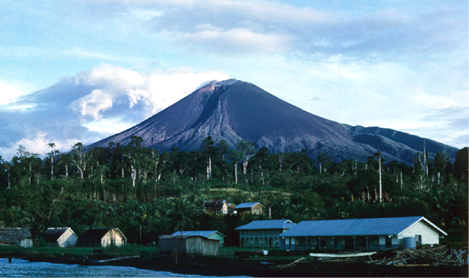
Figure 89. This is how Ulawun appeared from the north-west in 1967. Ulamona Mission and Sawmill are in the foreground. The deep north-western valley can be seen on the volcano itself, as well as the east-west escarpment low on the southern flank to the far right.
Source: R.F. Heming. Geoscience Australia (GA-8687-1).
None of the recent pyroclastic flows and lava flows from Ulawun have reached the coast and impacted on the communities there, although a pyroclastic flow in 1980 came menacingly close to Sule village and airstrip. Furthermore, ash falls have not caused as much damage as they appear to have done in 1915. High-rising ash clouds from Ulawun are, however, a threat to aviation, and there are concerns about the structural stability of Ulawun.
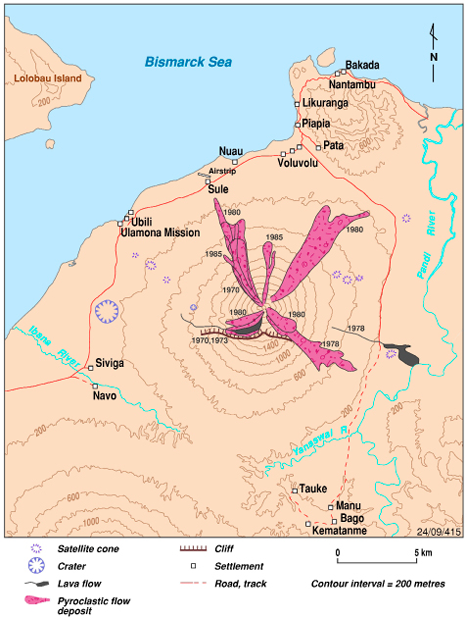
Figure 90. Ulawun volcano showing areas covered by 1970–1985 pyroclastic flows and lava flows. The volcano to the north-east of Ulawun is Likuruanga or North Son.
Source: Ulawun Workshop Report (1989, figure on p. 16).

Figure 91. Incandescent lava issues from several active vents along the fissure on the eastern flank of Ulawun volcano on 13 May 1978. The lava is seen from the west coalescing into a single, eastward-moving, and non-incandescent flow.
Source: R.J.S. Cooke. McKee et al. (1981b, Figure 9). Geoscience Australia (no registered number).
The structurally unstable condition of Ulawun began to be suspected during the 1970s and particularly during and after the 1978 eruption.9 An ‘apparent splitting’ of the volcano was observed high on the steep south-eastern side of the young cone on 7 May, and lava flowing from the top of the fissure and, reportedly, disappearing back into the volcano near the bottom of it. An even more unusual but significant phenomenon took place on 10 and 11 May when lava began flowing from a large number of vents on a linear fissure low down on the eastern flank of the volcano. This represents the first time that such a ‘flank’ eruption had been observed and recorded at any active volcano in Near Oceania. The flank fissure trended towards the summit of Ulawun, implying that the volcano is capable of producing magma along radial fractures deep within the volcano. A line of four, old, satellite cones that runs south-eastwards from near Ulamona on the western flank of Ulawun is evidence for another radial fracture, and there seems to be another radial alignment of small cones on the north-eastern flank too.
The danger at Ulawun, therefore, is that gravitational failure of the apparently over-steepened and over-heightened cone might take place, especially at times when magma injected into radial and other deep-seated fractures causes the volcano to swell and then fail. The danger is not just to the nearby coastal communities but also to settlements elsewhere in the Bismarck Sea, if a large debris avalanche entered the sea and caused a Ritter-like tsunami. This issue was addressed, 20 years after this period of activity, when a major international workshop on Ulawun volcano and volcanic-cone collapses was held at Walindi in West New Britain Province.10
Long Island Disaster and Tibito Tephra
Volcanic eruptions from sources within Lake Wisdom on Long Island are known to have started in 1953, 1955, 1968, 1973, 1976 and 1993, and they all seem to have been similar in character. An active volcano on the floor of the lake builds up to lake level, and produces what in most cases probably should have been strombolian eruptions, but which — because of the near-surface interaction of the magma with the lake water — are actually surtseyan, at least until an island is well formed. These eruptions are spectacular to witness and photograph from aircraft, particularly against the stunning background and natural beauty of Lake Wisdom and its surrounds, but so far they have not been disastrous for the people who live on Long Island, particularly as there are no villages on the lake shore. Nevertheless, some volcanic eruptions at Long Island in the not-so-distant past were not so benign.
Visitors to the seashore of Long Island cannot help but be struck by the youthful nature and extensive amounts of unconsolidated pumice and ash in the eroding coastal cliffs. These deposits include carbonised logs that are so well preserved they could be mistaken for the remnants of a recent forest fire, were they not buried by the pumice. Stories collected from coastal people on both Long Island and the mainland also refer to the youth of a major volcanic eruption that devastated the entire island. Taylor, for example, wrote of being informed by an Administration officer
that the eruption was of comparatively recent origin as stories of the escape from Arop [Long Island] are still evident among natives of the surrounding islands. It seems evident that some very alarming warning phenomena preceded this eruption as a considerable number of natives appear to have escaped from the island before the catastrophic eruption took place. [He] believes that the Siassi island people originally come from Long Island, and has found, on the harsher parts of the neighbouring New Guinea coast, settlements of natives who are also evacuees. One group, he believes, settled near the Lutheran Anchorage on northern Umboi but were subsequently wiped out by the 1888 eruption [sic] of Ritter Island.11
Early warning, evacuation, and recovery are also contained in a traditional story in which a long-haired man came to Long where the islanders wanted to kill him. A bikman of Long intervened, saved him, and then helped him build a canoe so that he could leave the island. The long-haired man in response warned the bikman of an impending disaster and advised him to flee with his family, which he did — to Crown Island. The eruption at Long wiped out those who remained on the island, but the bikman and his family eventually returned to establish a new community after which the island became bountiful in pigs, dogs and wild fowl.12
People came back to Long Island, apparently mainly in the latter half of the nineteenth century, presumably well after vegetation had reappeared on the island.13 The implication is that the eruption was so recent that it must have taken place since the first Europeans entered the region in the sixteenth century. There are, however, no records of this devastating eruption having been witnessed by early European voyagers, and information about the eruption comes from geological studies of the eruption deposits and from Melanesian oral history.
The young pumice and ash deposits that are exposed on the coast of Long Island have been called the Matapun Beds.14 Much of the material is ignimbrite — that is, pyroclastic material laid down by large pumice flows similar to those produced during the Krakatau eruption of 1883. The eruption, like Krakatau’s, was clearly a large one. Its total volume exceeded ten cubic kilometres and almost certainly the eruption was related to the formation of the large summit caldera that contains Lake Wisdom. Furthermore, the pumice and ash from the eruption would have been distributed well beyond the shores of Long Island.
Two academic geomorphologists, Colin F. Pain and Russell J. Blong, both New Zealanders, in 1970 began developing their research interest in the thick volcanic-ash beds found in the central highlands on the New Guinea mainland. They, and others, demonstrated through systematic mapping that many of the old tephras in the highlands originated, as expected, from the volcanoes of the mainland Fly-Highlands province.15 Australian archaeologists in 1970, however, were studying prehistoric drainage ditches exposed in the Kuk Tea Plantation east of Mount Hagen, and were curious about the origin of pale, thin, inorganic layers that were exposed by their excavations. They invited the opinion of Pain and Blong, who quickly deduced that the layers were volcanic ash. Did these ash layers also originate from the highlands volcanoes? This question triggered a great deal of scientific effort in mapping the ash layers. The youngest of the thin tephras intrigued Blong, in particular, and this set him off on a path of major research that resulted, finally, in publication in 1982 of The Time of Darkness, a book devoted to the subject of the single ash layer.16 This painstaking and time-consuming research involved further field mapping, ash-sample collection, analysis of the physical and chemical characteristics of the ash, and collection of numerous stories from Melanesian oral history,17 all aimed at elucidating the source and age of the ash and what effect it may have had on highlands communities. The ash was Tibito Tephra.
Tibito Tephra is not well preserved. The ash fell mainly on mountainous, forest-covered terrain characterised by heavy tropical rainfall, erosion, washouts, and reworking by people in gardens, and therefore identifying and tracking the tephra across country was much more difficult than had it fallen more conveniently in, say, arid central Australia. But Blong demonstrated that the ash thickened towards the east, and that the size of the ash particles increased in the same direction. He tracked Tibito Tephra to Long Island, and concluded that it was the distal equivalent of the Matapun Beds. This tephra was only one of many ash layers in the highlands that are thought to have originated from the volcanoes off the north coast of New Guinea in recent geological times. Discriminating between these ashes during fieldwork in the highlands is not easy, especially in the absence of subsequent chemical analyses, as stressed by more recent studies in the highlands by palaeoecologists.18
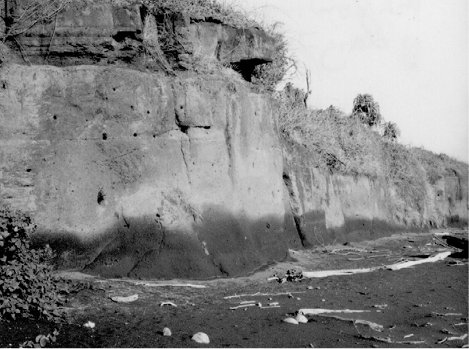
Figure 92. The pumice and ash of the Matapun Beds are here exposed in a five-metre-high cliff on the north-eastern coast of Long Island in 1970. The lower two-thirds of the cliff consist mainly of ignimbrite, which is overlain by layers of airfall ash.
Source: R.W. Johnson. Geoscience Australia (M-1114-8.tif).
The many Melanesian stories about the Long Island eruption and Tibito Tephra fallout are different in detail, but are valuable in making some general conclusions, particularly where matched with the scientific information about the pyroclastic materials preserved today on Long Island and in the highlands, and about the known effects of eruptions elsewhere in the world. The most disastrous effects almost certainly would have been experienced by any people who did not evacuate from Long Island. Human bones have been reported from the Matapun Beds,19 perhaps the remains of victims. Severe effects would also have been experienced by people in the mainland coastal areas to the west and south-west of the island where ash accumulations of five–ten centimetres or more probably caused house collapses in villages. Tsunamis too may have inundated settlements on long sections of the mainland coastline. Ash thicknesses on the mainland decrease to the west yet deposits there may have caused some deaths through ash accumulation and roof collapses — similar to the coastal communities — and by mudflows, but more importantly may have destroyed gardens and triggered food shortages and probably even famine over wider parts of the affected highlands.
The Matapun-Tibito eruption from Long is by far the largest known volcanic eruption to have taken place in Near Oceania in the last 500 years and, indeed, is one of the largest known anywhere in the world over the last 1,000 years or so. But when exactly did it take place? This question was debated intensely during the 1970s when biologists interested in post-eruption biological colonisation, archaeologists and anthropologists interested in past peoples, and geoscientists interested in the volcanic tephras, all combined in interdisciplinary field research on Long Island. Genealogical evidence pointed consistently to a time after 1700, the year when William Dampier passed by the island, noting that it was covered by lush vegetation.20 But such deductions from oral history are plagued with chronological uncertainty, especially where generations ‘drop out’ of genealogical sequences and where the lengths of generations are uncertain. Nevertheless, the first ‘radiocarbon ages’ to be obtained on the Matapun Beds — including some obtained by Taylor in the 1950s and 1960s — also pointed to a ‘modern’ post-1700 date, and the apparently late reoccupation of Long Island was consistent with a recent eruption too.
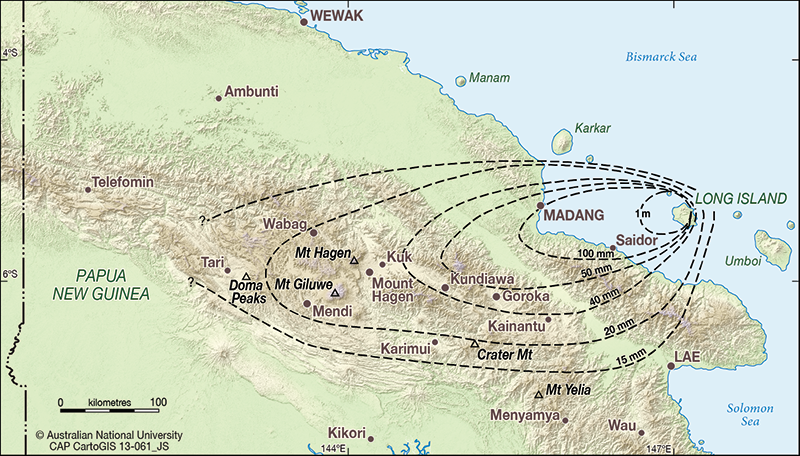
Figure 93. The inferred original thicknesses of Tibito Tephra, which was mapped by Russell Blong, are shown by the dashed lines extending from Long Island westwards across the present-day towns of the highlands region. Only a few of the Fly-Highlands volcanoes are shown.
Source: Adapted from a redesign by J. Golson and R.J. Blong of the original map published by Blong (1982, Figure 29).
Dampier published a sketch of how Long Island looked in profile in 1700 — low and flat-topped, more or less the way it is today — but this cannot be taken necessarily as evidence that the Matapun Beds had been laid down and a single Long Island caldera had already formed, by 1700. This is because the young Matapun–Tibito eruption was not the only one from which pumice and ash are preserved on Long Island. Older, voluminous, fragmental deposits are exposed at and near the coast, but also — and most noticeably — in the unscaleable walls of the Lake Wisdom caldera itself. In other words, major explosive eruptions have characterised the later geological history of Long Island and the caldera, therefore, may have formed by a series of collapses or subsidence events rather than by the single engulfment of an ‘ancestral mountain’. Also, was Dampier in fact correct about the shape of the island being ‘long’ in 1700, and did a post-1700 eruption change the outline of the island in plan into its present-day more equant form? An eruption sometime in the eighteenth or early nineteenth century — before Dumont D’Urville sailed passed the vegetation-covered island in 1827 — at first seemed most likely.21
Additional radiocarbon ages were obtained during the 1970s on the Matapun Beds and Tibito Tephra, by which time techniques for collecting carbon samples had improved significantly. Furthermore, the radiocarbon-dating method itself had become more sophisticated both in analytical technique and in interpretation of results. Blong stressed the inadequacies for dating purposes of oral history and genealogies, and argued for an eruption date somewhere between 1640 and 1670 on the basis of the radiocarbon results.22 His argument depended largely on unravelling the statistical uncertainties that had to be considered before converting the radiocarbon ages to the true dates of the modern calendar, but Blong’s general conclusion was supported strongly and independently by a radiocarbon specialist, the late Henry Polach, whom I had asked to investigate.23 Blong himself, however, remained cautious, stressing the uncertainties still involved and concluding that a post-1700 date for the eruption could not be ruled out completely.24 Such interpretations are still a common problem with young carbon samples, particularly in recognising that there will be a natural spread in radiocarbon dates of samples when an old forest, including trees perhaps more than a century old, are overwhelmed by the products of a severe explosive eruption. The Long–Tiboto data represent a good example of all the uncertainties involved.25
Sulphuric-acid aerosols injected into the stratosphere by the Matupun–Tibito eruption at Long Island may well have caused the same kind of brilliance in worldwide sunsets seen after the Krakatau eruption in 1883. Volcanic aerosols from large equatorial eruptions are slow to settle out of the atmosphere. They drift to the polar regions of the Earth over a period of many months, where eventually they are caught up in snow falls and become incorporated in the sequence of annual layers that can be counted in ice cores drilled in glaciers. A prominent acid-rich layer has been identified in ice cores from Greenland, dated at 1645 AD, and attributed to Long Island.26 This is close to the year of 1643 when Abel Tasman sailed past Long Island, but he made no reference to the state of the island.
Yomba and Cook: Two ‘Mystery’ Volcanoes
The Long Island story has an addendum. Villagers on the coastlines near Madang on the mainland facing Long Island, have stories — collected in the 1970s — of an island called Yomba that sank beneath the sea eight–ten generations previously.27 Some tellers of the stories said that their ancestors lived on the island and escaped to the mainland and other islands where their descendants live today. Some versions of the story refer to a large devastating tsunami, some to a volcanic eruption and accompanying time of darkness. All of the informants were in agreement that Yomba was not Long Island and that it had disappeared before the latest major eruption at Long.
Some of the informants said that Yomba Island was where Hankow Reef is today, about 50 kilometres north-west of Long and more or less in line with the other volcanoes of the western Bismarck Volcanic Arc. The coral reef at Hankow almost certainly has a volcanic basement so the oral history relating to the existence of a volcanic Yomba Island is generally consistent with this inferred geology. The Yomba stories carry elements of major geophysical catastrophe, but the scientific evidence for this is yet to be found. A major volcanic collapse at Yomba within, say, the last 1,000 years — either caldera formation and an accompanying explosive eruption, or major gravitational collapse such as at Ritter in 1888 — is considered unlikely on the basis of the results of a major side-scan sonar survey of the sea floor around Hankow Reef in 2004.28 Furthermore, no tephras have been found that might be traced back specifically to Yomba. The reputed volcanic island could have been low-lying and therefore, perhaps, vulnerable to the effects of a major earthquake or tsunami, but again, the supporting evidence has yet to be found. Nevertheless, the strength of the oral history from the Madang area cannot easily be swept aside and the questions about the existence and disappearance of Yomba Island remain unanswered.
Claims about the origin of, and recent volcanic activity at, another ‘shoal’ in Near Oceania have also been scrutinised. Cook submarine volcano in the New Georgia Group of the western Solomon Islands was marked on a British Admiralty map as a 36-metre-deep shoal after a British naval vessel, HMS Cook, reported an uncharted submarine disturbance, including a sulphuretted smell, on 14 December 1963. The disturbance took place just a few kilometres off Munda Point on southern New Georgia Island. The shoal itself, however, was detected at night using only primitive, backup, depth-sounding instruments. A strong earthquake took place in the same general area 20 days afterwards and, in May 1965, two young villagers in a canoe saw a large mass of water rise from the same area, then fall back again into the sea. A submarine volcano was postulated and called ‘Cook’ by John Grover, head of the British Solomon Islands Geological Survey in Honiara.29 Detailed marine geophysical surveys in later years, however, failed to detect any sea floor volcano large enough to have a summit as shallow as 36 metres below sea level.30 The cause of the sea-surface disturbances may have been a hydrothermal blowout from the sea floor, perhaps related to seismic activity and sea floor faulting. Cook submarine volcano, therefore, appears to be modern myth.
Fatal Eruption on Karkar in 1979
The RVO observation camp near the southern rim of the inner caldera of Karkar had a spectacular vantage point from which to view the 1974–1975 eruptions at Bagiai Cone, about 260 metres high and two kilometres away, down on the floor of the caldera.31 Bagiai, or Bagia, is also the traditional name for the 3.2-kilometre-wide inner caldera. The panorama from the southern rim of the caldera and its lava-field covered floor was also enhanced by the escarpment of an older and outer caldera forming a forested backdrop in the distance.
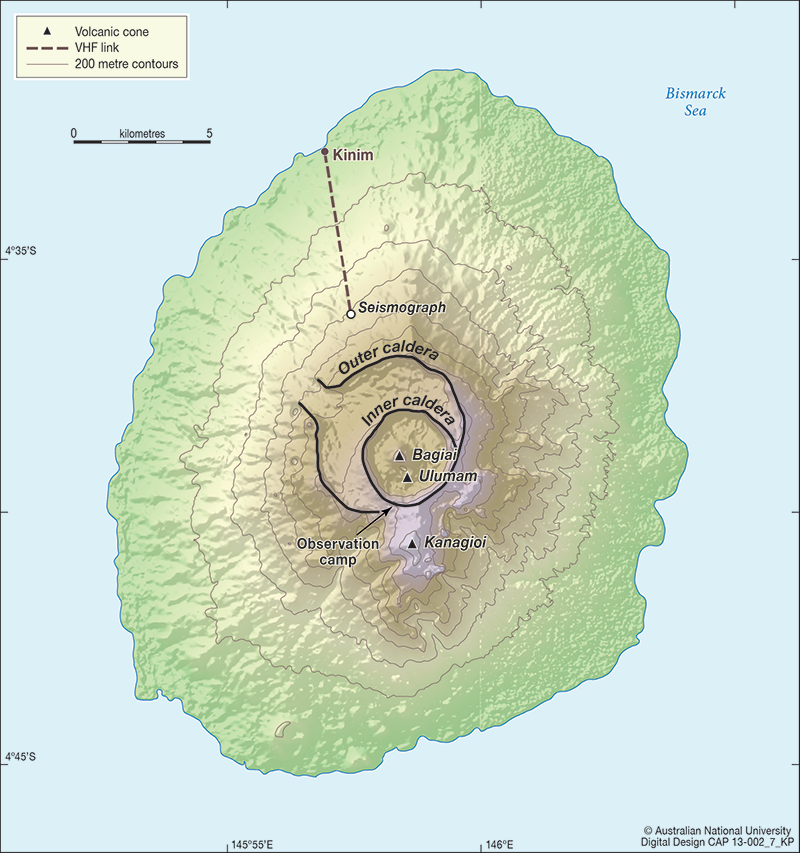
Figure 94. The summit of Karkar Island is dominated by the peak of Kanagioi and by the two calderas. Kanagioi is either a satellite volcanic cone like many others found on the northern and southern slopes of the island — but not identified in this map — or else is the last remaining one of a cluster of summit volcanoes that were largely engulfed when the calderas formed.
Source: Adapted from McKee et al. (1976, Figure 1).
Vulcanian–strombolian eruptions in February–August 1974 and December 1974 to February 1975 were impressive enough during the day, but at night the pyrotechnic sprays of glowing lava fragments from Bagiai could be truly impressive. Great volumes of new lava and fallouts of ash in 1974–1975 also spread out over most of caldera floor, transforming its former vegetation-covered aspect.
The summit area of the island, including the highest peak Kanagioi, is unpopulated and traditionally was regarded as being inhabited by deities and the spirits of dead ancestors as well as fiends who exist alongside humans in the physical universe. An Australian anthropologist working on Karkar in the mid-1960s found that her informants had traditional belief systems which incorporated elements of Christianity, aspirations for acquiring European knowledge and material wealth, efforts to understand the origin of Europeans, and elements of cargo cultism. This syncretic approach to acquiring a new world view also involved the volcanic features at, and inferred volcanic sounds from, the summit of Karkar Island:
Spirits of the dead went to live first in the volcanic crater, Bagia. Here, Kulbob [a mythical creation deity], assisted by the ancestor, Karkar [the first human being], supervised factories and workshops, whose sounds of production had long been a part of local legend … . Here, too Jesus imparted ‘real’ knowledge, and Misken, the minor mountain deity, acted as guardian and companion of the spirits as she had done traditionally. Heaven was Kanagioi itself …32
A permanent seismograph had been installed by RVO in June 1975 on the north-western flank of the island and was connected by VHF telemetry to a manned receiving post at Kinim to the north. Evidence for volcano reactivation was detected between November 1977 and July 1978 when there was an increase in volcanic earthquakes, and then water vapour and gas emissions became more noticeable from the caldera floor near the south-east foot of Bagiai and the surrounding area in September 1978. Explosive activity eventually broke out there on 12 or 13 January 1979. RVO staff were exchanging periods of duty at the observation camp on the caldera rim, and Cooke and volcanological assistant Elias Ravian were there on the evening of 7 March, equipped with a voice radio, and about to be relieved on 11 or 12 March. The details of what happened during the night are not clear, but three large volcanic earthquakes were felt at the coast between 0100 and 0132 hours on the 8 March, accompanied by a dense black cloud rising up from the summit area.
Cooke and Ravian did not make radio contact the next morning and a ground party climbed to the caldera rim to investigate.33 They found evidence that a powerful volcanic explosion had taken place from near the foot of Bagiai. The explosion had blasted laterally and south-eastwards, and had stripped vegetation from the caldera wall and from a crescent-shaped area of rain forest on the caldera rim itself. The RVO observation camp was just within the western tip of the crescent. The bodies of Cooke and Ravian were found at the camp, buried under about 15 centimetres of ash, the area clearly having been bombarded by hot ash and by rocks up to a metre in diameter. Large forest trees showing signs of charring were shredded, their limbs broken off and reduced to bare trunks. McKee and Talai flew from Rabaul to Karkar on 9 March and joined a group who arranged for the bodies of Cooke and Ravian to be removed from the summit by helicopter and returned by air to Rabaul. Cooke had been working on several volcanological manuscripts and had them with him at the campsite. These were recoverable, although many pages had been severely charred by the hot lateral blast.
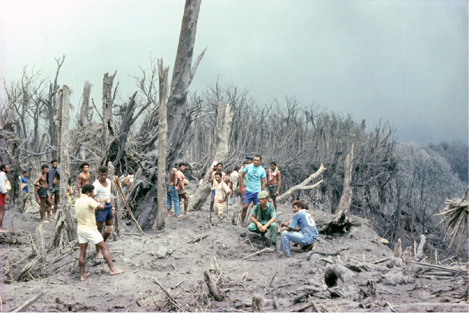
Figure 95. Devastation at the RVO observation campsite is seen in this photograph, taken on 9 March 1979, in what previously was lush tropical rain forest. Bagiai and the inner caldera are down to the right.
Source: C.O. McKee, Rabaul Volcanological Observatory.
The fatal eruption of 8 March created anxiety on Karkar Island because of fear that the intensity of the eruptions might escalate and affect coastal communities. Discussions were held about the possibility of an evacuation of the island being necessary, but the volcanic threat died away in the following weeks and months. Furthermore, the March eruption was assessed to be of localised hydrovolcanic type, strongly influenced by the access of rainwater to a body of magma beneath Bagiai. A new crater at the foot of Bagiai had been greatly widened and deepened, and it appeared to be a maar, much like the ones formed by hydroexplosive activity at Goropu in 1943–1944. McKee and colleagues were later able to correlate periods of heavy rainfall at Karkar with smaller explosive phases that continued from the maar after the deadly explosion of 8 March.34 The Karkar crisis of 1978–1979 was the closest that RVO came during the 1970s to considering the possibility of an evacuation, in contrast to the 1950s when four volcanic crises involved the displacement of people.
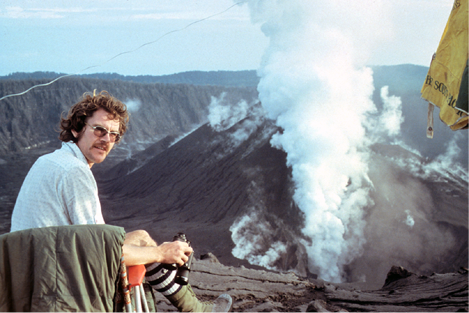
Figure 96. Chris McKee is seen here at the observation camp on the caldera rim at Karkar in 1979 after the fatal eruption of 8 March. Bagiai is in the foreground, together with the new maar-like crater emitting water vapour. The walls of both the inner and outer caldera are visible in the background.
Source: Photograph supplied by C.O. McKee.
The sudden deaths of Cooke and Ravian devastated not only their immediate families, friends and colleagues, but also shocked the wider community in both Papua New Guinea and Australia, as well as volcanologists internationally who had known Rob personally. Cooke was buried in the European cemetery in Rabaul, and Ravian at his village, but the two names are linked in the memorial that was erected for them at RVO headquarters and in a volume of scientific papers, including several by Cooke, that was later published in their honour.
References
Ball, E.E. & I.M. Hughes, 1982. ‘Long Island, Papua New Guinea — People, Resources and Culture’, Records of the Australian Museum, 10, pp. 463–25.
Ball, E.E. & R.W. Johnson, 1976. ‘Volcanic History of Long Island, Papua New Guinea’, in R.W. Johnson (ed.), Volcanism in Australasia. Elsevier, Amsterdam, pp. 133–47.
Blong, R.J., 1979. ‘Time of Darkness Legends from Papua New Guinea’, Oral History, 7, no. 10, pp. 1–135.
——, 1982. The Time of Darkness. The Australian National University Press, Canberra.
Bultitude, R.J., 1979. Bagana Volcano, Bougainville Island: Geology, Petrology, and Summary of Eruptive History between 1875 and 1975, Geological Survey of Papua New Guinea Memoir 6.
Cooke, R.J.S., 1975. ‘Time Variations in Recent Volcanism and Seismicity along Convergent Boundaries of the South Bismarck Sea, Papua New Guinea’, Australian Society of Exploration Geophysicists Bulletin, 6, pp. 77–78.
——, 1981. ‘Notes on the Activity of Ulawun Volcano, 1700–1958: Results of a Literature Search’, in R.W. Johnson (ed.), Cooke-Ravian Volume of Volcanological Papers. Geological Survey of Papua New Guinea Memoir, 10, pp. 147–51.
Cooke, R.J.S., C.O. McKee, V.F. Dent & D.A. Wallace, 1976. ‘Striking Sequence of Volcanic Eruptions in the Bismarck Volcanic Arc, Papua New Guinea, in 1972–75’, in R.W. Johnson (ed.), Volcanism in Australasia. Elsevier, Amsterdam, pp. 149–72.
Egloff, B.J. & J. Specht, 1982. ‘Long Island, Papua New Guinea — Aspects of the Prehistory’, Records of the Australian Museum, 10, pp. 427–46.
Exon, N.F. & R.W. Johnson, 1986. ‘The Elusive Cook Volcano and other Submarine Forearc Volcanoes in the Solomon Islands’, BMR Journal of Australian Geology and Geophysics, 10, pp. 77–83.
Fisher, N.H., 1937. Geological Report on an Ascent of the Father Volcano, New Britain. Territory of New Guinea. Australian Department of External Territories, Canberra. National Australian Archives, Canberra, Series A518, Item AB836/4 (New Guinea: Volcanic Eruption — Visit of Stehn, Cilento and Woolnough), three unnumbered folios.
Geological Survey Staff, 1979. ‘Fatal Eruption of Karkar Volcano 8 March 1979’, Geological Survey of Papua New Guinea Report 79/10.
Grover, J.C., 1968. ‘Submarine Volcanoes and Oceanographic Observations in the New Georgia Group 1963–1964’, British Solomon Islands Geological Record, 3, pp. 116–25.
Haberle, S.G., 1998. ‘Dating the Evidence for Agricultural Change in the Highlands of New Guinea: the Last 2000 Years’. Australian Archaeology, 47, pp. 1–19.
Harding, T.G., 1967. Voyagers of the Vitiaz Strait: a Study of a New Guinea Trade System. University of Washington Press, Seattle.
Johnson, R.W., R.A. Davies & A.J.R. White, 1972. Ulawun Volcano, New Britain. Bureau of Mineral Resources, Canberra, Bulletin 142.
Johnson, R.W., R.P. Macnab, R.J. Arculus, R.J. Ryburn, R.J.S. Cooke & B.W. Chappell, 1983. ‘Bamus Volcano, Papua New Guinea: Dormant Neighbour of Ulawun, and Magnesian-Andesite Locality’, Geologische Rundschau, 72, pp. 207–37.
Johnson, R.W. & D. Tuni, 1987. ‘Kavachi, an Active Forearc Volcano in the Western Solomon Islands: Reported Eruptions between 1950 and 1982’, in B. Taylor & N.F. Exon (eds), Marine Geology, Geophysics, and Geochemistry of the Woodlark Basin–Solomon Islands. Circum-Pacific Council for Energy and Mineral Resources Earth Science Series, 7, pp. 89–112.
McKee, C.O., 1983. Volcanic Hazards at Ulawun Volcano. Geological Survey of Papua New Guinea Report, 83/13.
——, 1989. ‘Ulawun’, in L. McClelland, T. Simkin, M. Summers, E. Nielsen & T.C. Stein (eds), Global Volcanism 1975–1985. Prentice Hall, Englewood Cliffs, New Jersey, pp. 175–76.
McKee, C.O., R.J.S. Cooke & D.A. Wallace, 1976. ‘1974–75 Eruptions of Karkar Volcano, Papua New Guinea’, in R.W. Johnson (ed.), Volcanism in Australasia. Elsevier, Amsterdam, pp. 173–90.
McKee, C.O. & D.A. Wallace, 1981. ‘Lava Fields in the Inner Caldera of Karkar Volcano’, in R.W. Johnson (ed.), Cooke-Ravian Volume of Volcanological Papers. Geological Survey of Papua New Guinea Memoir, 10, pp. 49–62.
McKee, C.O., D.A. Wallace, R.A. Almond & B. Talai, 1981a. ‘Fatal Hydroeruption of Karkar Volcano in 1979: Development of a Maar-like Crater’, in R.W. Johnson (ed.), Cooke-Ravian Volume of Volcanological Papers. Geological Survey of Papua New Guinea Memoir, 10, pp. 63–84.
McKee, C.O., R.A. Almond, R.J.S. Cooke & B. Talai, 1981b. ‘Basaltic Pyroclastic Avalanches and Flank Effusion from Ulawun Volcano in 1978’, in R.W. Johnson (ed.), Cooke-Ravian Volume of Volcanological Papers. Geological Survey of Papua New Guinea Memoir, 10, pp. 153–65.
McSwain, R., 1977. The Past and Future People: Tradition and Change on a New Guinea Island. Oxford University Press, Melbourne.
Mennis, M.R., 1981. ‘Yomba Island: A Real or Mythical Volcano?’, in R.W. Johnson (ed.), Cooke-Ravian Volume of Volcanological Papers. Geological Survey of Papua New Guinea Memoir, 10, pp. 95–99.
Mori, J., C. McKee, I. Itikarai, P. Lowenstein, P. de Saint Ours & B. Talai, 1989. ‘Earthquakes of the Rabaul Seismo-deformational Crisis September 1983 to July 1985: Seismicity on a Caldera Ring Fault’, in J.H. Latter (ed.), Volcanic Hazards. IAVCEI Proceedings in Volcanology, 1, pp 429–62.
Pain, C.F. & R.J. Blong, 1976. ‘Late Quaternary Tephras around Mount Hagen and Mount Giluwe’, in R.W. Johnson (ed.), Volcanism in Australasia. Elsevier, Amsterdam, pp. 239–51.
Pain, C.F., R.J. Blong & C.O. McKee, 1981. ‘Pyroclastic Deposits and Eruptive Sequences of Long Island. Part 1: Lithology, Stratigraphy, and Volcanology’, in R.W. Johnson (ed.), Cooke-Ravian Volume of Volcanological Papers. Geological Survey of Papua New Guinea Memoir, 10, pp. 101–07.
Polach, H., 1981. ‘Pyroclastic Deposits and Eruptive Sequences of Long Island. Part 2: Radiocarbon Dating of Long Island and Tibito Tephras’, in R.W. Johnson (ed.), Cooke-Ravian Volume of Volcanological Papers. Geological Survey of Papua New Guinea Memoir, 10, pp. 108–13.
Silver, E., S. Day, S. Ward, G. Hoffmann, P. Llanes, N. Driscoll, B. Applegate & S. Saunders, 2009. ‘Volcanic Collapse and Tsunami Generation in the Bismarck Volcanic Arc, Papua New Guinea’, Journal of Volcanology and Geothermal Research, 186, pp. 210–22.
Stamm, J., 1961. Unpublished and untitled letter to G.A.M. Taylor, 4 May. RVO File V.F/9A (R.O.1/1/4), Folios 48 & 49.
Taylor, G.A.M., 1953. ‘Notes on Ritter, Sakar, Umboi and Long Island Volcanoes’. Bureau of Mineral Resources, Canberra, Record 1953/43.
Ulawun Workshop Report, 1989. Volcanic Cone Collapses and Tsunamis: Issues for Emergency Management in the Southwest Pacific Region. IAVCEI Workshop on Ulawun Decade Volcano, Papua New Guinea. International Decade for Natural Disaster Reduction, Emergency Management Australia, Canberra.
Vicedom, G.F. & H. Tischner, 1977 (1943). Myths and Legends from Mount Hagen, Andrew Strathern (trans.). Institute of Papua New Guinea Studies, Port Moresby.
Wallace, D.A., R.J.S. Cooke, V.F. Dent, D.J. Norris & R.W. Johnson, 1981. ‘Kadovar Volcano and Investigations of an Outbreak of Thermal Activity in 1976’, in R.W. Johnson (ed.), Cooke-Ravian Volume of Volcanological Papers. Geological Survey of Papua New Guinea Memoir, 10, pp. 1–11.
Zielinski, G.A., P.A. Mayewski, L.D. Meeker, S. Whitlow, M.S. Twickler, M. Morrison, D.A. Meese, A.J. Gow & R.B. Alley, 1994. ‘Record of Volcanism since 7000 B.C. from the GISP2 Greenland Ice Core and Implications for the Volcano-Climate System’, Science, 264, pp. 948–52.
1 Cooke (1975) and Cooke et al. (1976).
2 Wallace et al. (1981).
3 Mori et al. (1989).
4 Cooke & others (1976).
5 Cooke (1975) and Cooke et al. (1976).
6 Johnson et al. (1972), Cooke et al. (1976), McKee et al. (1981b), and McKee (1983, 1989).
7 Stamm (1961), p. 2. See also Cooke (1981).
8 Fisher (1937).
9 McKee et al. (1981b). See also Johnson et al. (1983).
10 Ulawun Workshop Report (1989).
11 Taylor (1953), pp. 4–5.
12 Harding (1967), note, p. 133.
13 Ball & Hughes (1982).
14 Pain et al. (1981).
15 Pain & Blong (1976).
16 Blong (1982).
17 Blong (1979). See also, for example, Vicedom & Tischner (1943).
18 Haberle (1998).
19 Egloff & Specht (1982).
20 Ball & Johnson (1976) and Blong (1982).
21 Ball & Johnson (1976).
22 Blong (1982).
23 Polach (1981).
24 Blong (1982). See also, Haberle (1998).
25 A more modern radiocarbon-dating technique that should be considered for Long Island carbon samples is the so-called ‘wiggle-match’ method where 14C dates are obtained for multiple samples taken from core to rim on individual logs, and then finding the best match. for the sequence of dates against a calendar-year versus 14C-date calibration curve. C.O. McKee (personal communication, 2012) recently applied this technique to the dating of a carbonised log from Rabaul.
26 Zielinski et al. (1994).
27 Mennis (1981).
28 Silver et al. (2009).
29 Grover (1968).
30 Exon & Johnson (1986).
31 McKee et al. (1976) and McKee & Wallace (1981)
32 McSwain (1977), p. 171.
33 Geological Survey Staff (1979).
34 McKee & others (1981a).